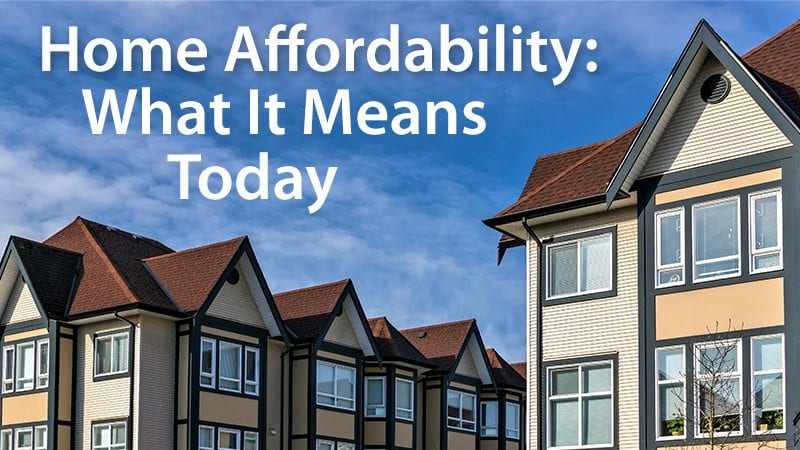
What Does It Mean To Afford A Home, Anyway?
When it comes to the question of who can afford a home, the usual answer involves a bunch of dollar signs and statistics.
Surely money is part of the equation but if you’re not also looking at personal preferences, you may well make a financial decision that will be uncomfortable for a very long time.
Click to see today’s rates (Feb 13th, 2017)
Lender Requirements By The Numbers
When it comes to originating loans, lenders have strict requirements. Their benchmarks — and there are thousands of pages of rules and guidelines — really come down to two central measures.
First, the lender wants to know if you have the ability to repay the loan. To answer this question, a loan underwriter (or piece of software) looks at such things as income, debts and assets. That shows your ability to repay — that you have the income necessary, and some back-up assets if your income is interrupted.
The lender also wants to measure your willingness to repay a home loan. That’s what underwriters look for when they analyze your credit scores and credit reports.
What the lender wants to see is that not only does the borrower have the financial capacity to repay the debt but also a history which says the borrower will repay, wants to repay, and that repaying is important.
DTI Ratios
Second, loan programs have requirements which limit the amount of debt acceptable to lenders and investors, what is known as the debt-to-income (DTI) ratio.
For example, most loan programs today limit the DTI to 43 percent of the borrower’s gross (before tax) income.
Let’s say your household has two wage earners and a combined monthly income of $7,500. If 43 percent of your gross monthly income can be devoted to recurring debt payments, then you can spend as much as $3,225 on such things as housing, auto loans, student debt and credit card bills.
Some lenders go beyond program requirements and “overlay” their own more rigorous standards. If a Fannie Mae lender says borrowers must have a 41 percent debt-to-income ratio instead of 43 percent, then the so-called “credit box” will be smaller.
In this case, 41 percent of $7,500 is $3,075. That’s $150 less per month than a more liberal DTI allowance and potentially a fatal financial barrier for marginal borrowers.
Click to see today’s rates (Feb 13th, 2017)
Calculating Affordability
Let’s imagine that our model household has two auto loans ($1,000 a month total), student debt ($400), credit card payments (a $100 minimum). That’s a total of $1,500.
We can then subtract $1,500 from $3,225 and the amount remaining for housing costs — mortgage principal, mortgage interest, property taxes and property insurance (PITI to lenders) is $1,725.
Notice that the $1,725 does not go just for mortgage interest and mortgage principal. It also includes insurance and taxes. If insurance is $200 a month and taxes are $300, then $1,275 remains for principal and interest. That translates to about $259,000 in financing at 4.25 percent.
Afford A Home, A Personal Choice
A by-the-numbers approach tells us generally how much home borrowers can afford. The catch is that real estate is not a tax form, more than numbers are involved.
We live in a changing economy, and for many this means new alternatives in communities and housing. Greater numbers of us are “distance workers” who earn in one place but can live elsewhere. This means living well and having a smaller mortgage are hardly exclusive or unthinkable.
According to ADP, “the future of work is shifting towards alternative schedules that allow employees to focus on their priorities, which in this case is a healthy lifestyle and more time for family and friends.”
“The Millennial workforce wants to work a more flexible schedule,” says the Voice of America, “This could mean the end of the inflexible 40-hour work week.”
If work hours and the point of work is evolving, then financial habits may also be ripe for change.
A smart financial strategy going forward may mean more savings, fewer bills, less debt and smaller mortgages. People may be happier with less stuff and smaller homes. The size of the average home went from 1,695 square feet in 1974 to 2,687 square feet in 2015.
In turn, smaller homes may mean smaller mortgages. Books such as Small Is Beautiful and The Millionaire Next Door argue that spending less can produce a better lifestyle and fewer daily hassles.
What Are Today’s Mortgage Rates?
For mortgage lenders — and thus for borrowers — such new trends are likely to be very welcome. After all, borrowers with less debt and more savings are easier to qualify for financing, especially if borrowers as a matter of choice are not seeking the largest possible mortgage.
Borrowing less than you can afford makes you a more attractive candidate to mortgage lenders. This allows you to qualify for better mortgage rates, lower closing costs and nicer terms.
Click to see today’s rates (Feb 13th, 2017)
The information contained on The Mortgage Reports website is for informational purposes only and is not an advertisement for products offered by Full Beaker. The views and opinions expressed herein are those of the author and do not reflect the policy or position of Full Beaker, its officers, parent, or affiliates.
the-easier-way-to-afford-a-home

No comments:
Post a Comment